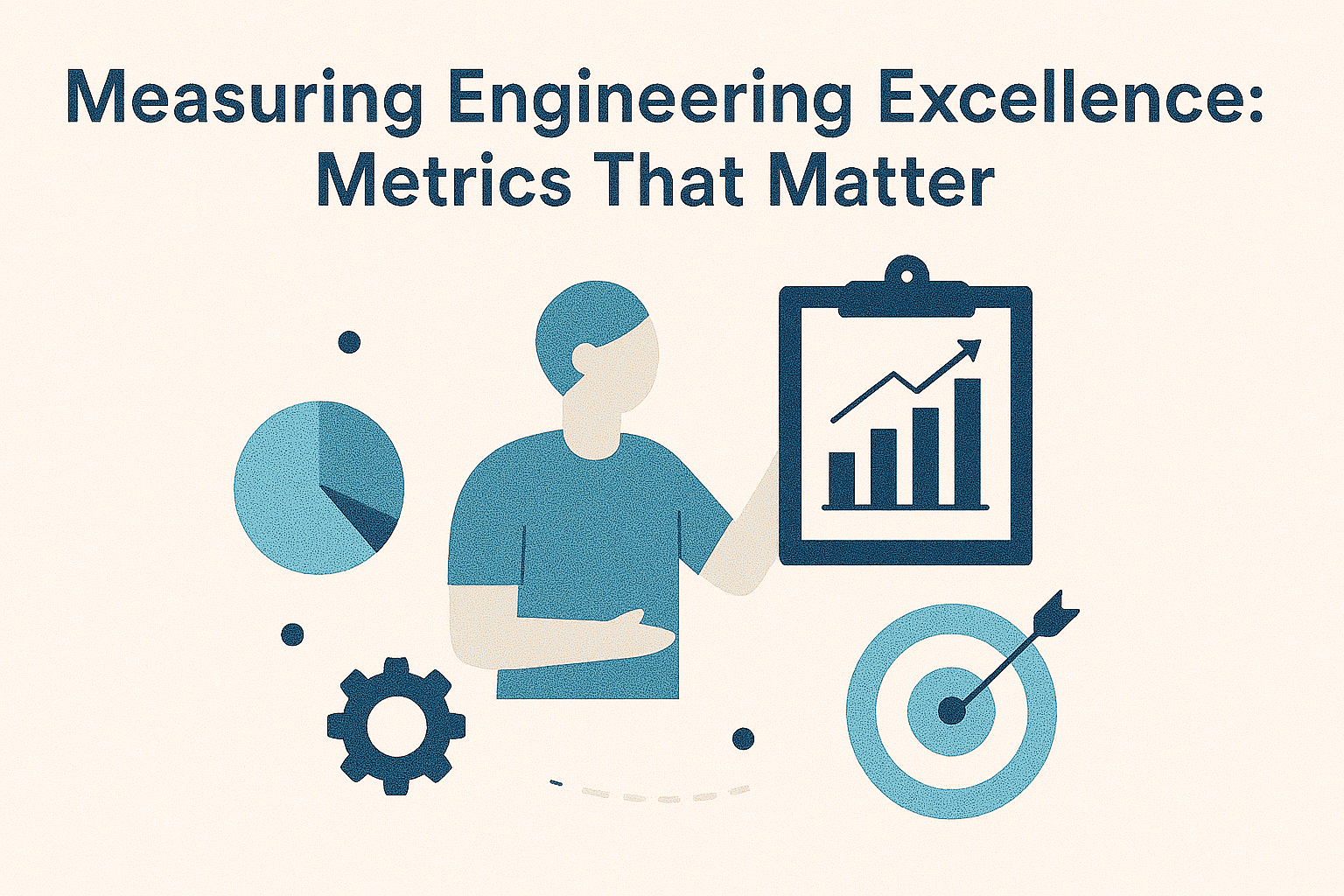Measuring Engineering Excellence: Metrics That Matter

Engineering excellence is a phrase we hear often - but defining it, let alone measuring it, is far more complex. It’s not about lines of code, the number of pull requests, or whether the build is green. True engineering excellence is about delivering value sustainably, safely, and at speed - with quality, collaboration, and continuous improvement at its core.
But here’s the challenge: you get what you measure. And in many organisations, we’re still incentivising the wrong things - output over outcomes, speed over stability, motion over progress.
If we want to build high-performing engineering teams, we need to shift our focus to metrics that truly matter. Ones that reflect not just what’s being built, but how it’s built, how well it performs, and how healthy the teams are who build it.
Why Measuring Engineering Excellence Matters
Metrics provide focus. They shape behaviours. They tell a story about our engineering culture. When chosen well, they drive the right conversations and unlock improvement. When chosen poorly, they distort priorities, create perverse incentives, and stifle innovation.
Engineering excellence requires a balanced view - spanning delivery performance, operational resilience, technical quality, and team health. This is not about vanity metrics; it’s about enabling better decisions, fostering ownership, and supporting long-term sustainability.
The Four Dimensions of Engineering Excellence
Let’s explore the metrics that matter across four interconnected domains:
1. Delivery Performance
Are we delivering value to users quickly and reliably?
These metrics provide insight into flow efficiency and the team’s ability to move ideas into production:
Lead Time for Changes: How long does it take from code commit to production? Shorter times indicate faster feedback loops and more responsive teams.
Deployment Frequency: How often do we ship? High frequency suggests mature CI/CD pipelines and smaller, safer increments of change.
Change Failure Rate: What proportion of deployments lead to incidents, rollbacks, or defects? This reflects the stability of our delivery.
Mean Time to Recovery (MTTR): When things go wrong, how quickly can we recover? Lower MTTR indicates resilient systems and good operational readiness.
These are the "Accelerate metrics" - validated through research to correlate with business performance and team satisfaction.
2. Technical Quality
Are we building systems that are sustainable, secure, and scalable?
Speed without stability is fragile. Technical excellence ensures we’re laying down durable foundations.
Code Quality Indicators: Test coverage on critical paths, static code analysis scores, code complexity metrics.
Tech Debt Ratio: Effort spent maintaining or fixing versus building new capabilities. Track this trend over time.
Security Posture: Time to resolve known vulnerabilities, number of open CVEs, coverage of automated security tests.
Reliability and Performance: Uptime, latency, error rates, and user journey success. Observability matters.
Quality metrics help surface risks before they become constraints. But they work best when paired with team ownership - not top-down policing.
3. Team Health and Culture
Are our teams set up to succeed - not just deliver, but grow?
Healthy teams are the foundation of sustainable excellence. Yet team experience is often the most under-measured area.
Psychological Safety: Do team members feel safe to speak up, ask questions, and challenge ideas?
Flow Time vs. Wait Time: How much of a developer’s time is spent actually building versus waiting (on reviews, builds, or decisions)?
Developer Satisfaction and Engagement: Pulse surveys, eNPS scores, and anecdotal feedback.
Time Allocated to Learning and Innovation: Are teams investing in their own growth?
If teams are burnt out, blocked, or disconnected from purpose, engineering excellence is impossible - no matter how fast we ship.
4. Collaboration and Continuous Improvement
Are we learning and improving together, or just repeating the same patterns?
Great teams get better over time. They reflect, adapt, and evolve - not just their code, but their ways of working.
Review Responsiveness: Average time to review code, number of reviewers per PR, comments per change.
Retrospective Follow-Through: Percentage of agreed actions completed, cycle time to resolution.
Cross-Team Dependency Resolution Time: How quickly do we unblock each other?
Experimentation Rate: How often are new ideas tested or explored?
These metrics elevate the importance of communication, learning, and shared responsibility - hallmarks of a mature engineering culture.
A Word of Caution
Metrics are powerful, but they can be dangerous when misused. Avoid:
Metric overload: Focus on a curated, purposeful set - not a dashboard of everything.
Misaligned incentives: Don’t gamify metrics or use them for punishment.
Lagging indicators only: Combine outcome metrics with leading indicators of behaviour and process health.
The goal is insight, not inspection.
Key Takeaways
✅ Engineering excellence is multi-dimensional - it’s not just about velocity, but also quality, resilience, and team capability.
✅ Use balanced metrics that span delivery, technical health, team wellbeing, and collaboration.
✅ Focus on trends, not absolutes. Metrics are more useful when they prompt questions, not binary judgments.
✅ Create a culture of trust and transparency where teams feel ownership of their metrics and use them to drive improvement.
✅ Don’t measure for measurement’s sake - align metrics with strategic goals and lived experiences on the ground.
Final Thought
If we truly believe engineering is a strategic differentiator, then we must treat engineering measurement as a strategic act - not an administrative one.
The right metrics won’t just show how we’re doing. They’ll illuminate where to go next, how to get better, and what’s holding us back.
Because in the end, engineering excellence isn’t about being perfect.
It’s about getting better, every day - and knowing how to measure the progress that really matters.
Engineering leader blending strategy, culture, and craft to build high-performing teams and future-ready platforms. I drive transformation through autonomy, continuous improvement, and data-driven excellence - creating environments where people thrive, innovation flourishes, and outcomes matter. Passionate about empowering others and reshaping engineering for impact at scale. Let’s build better, together.
